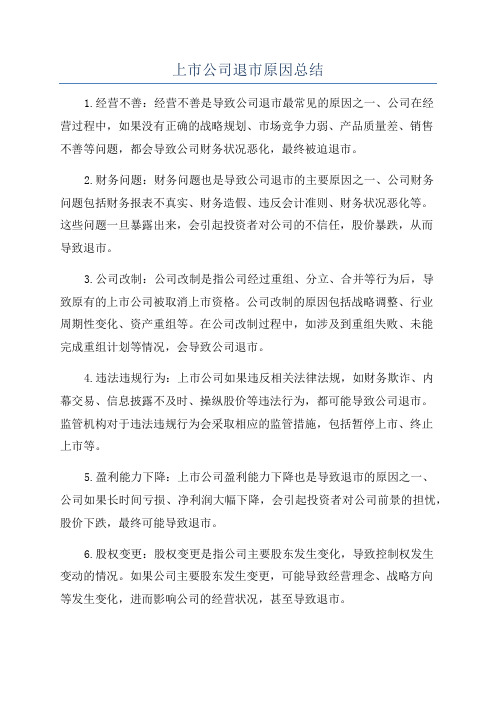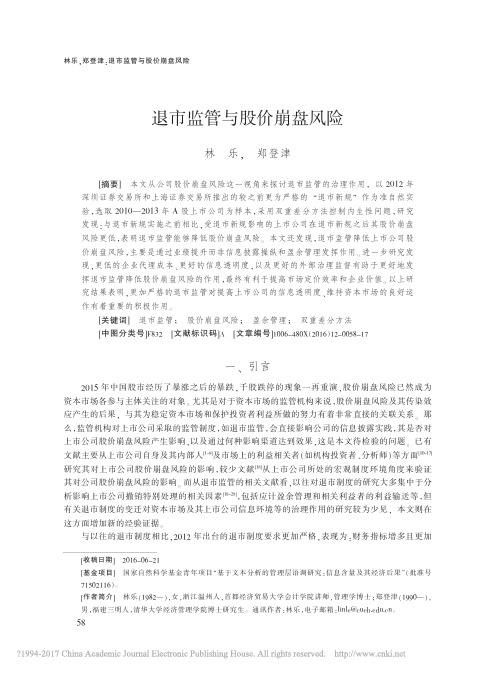上市公司退市制度对ST股的不利因素分析
上市公司退市原因总结

上市公司退市原因总结1.经营不善:经营不善是导致公司退市最常见的原因之一、公司在经营过程中,如果没有正确的战略规划、市场竞争力弱、产品质量差、销售不善等问题,都会导致公司财务状况恶化,最终被迫退市。
2.财务问题:财务问题也是导致公司退市的主要原因之一、公司财务问题包括财务报表不真实、财务造假、违反会计准则、财务状况恶化等。
这些问题一旦暴露出来,会引起投资者对公司的不信任,股价暴跌,从而导致退市。
3.公司改制:公司改制是指公司经过重组、分立、合并等行为后,导致原有的上市公司被取消上市资格。
公司改制的原因包括战略调整、行业周期性变化、资产重组等。
在公司改制过程中,如涉及到重组失败、未能完成重组计划等情况,会导致公司退市。
4.违法违规行为:上市公司如果违反相关法律法规,如财务欺诈、内幕交易、信息披露不及时、操纵股价等违法行为,都可能导致公司退市。
监管机构对于违法违规行为会采取相应的监管措施,包括暂停上市、终止上市等。
5.盈利能力下降:上市公司盈利能力下降也是导致退市的原因之一、公司如果长时间亏损、净利润大幅下降,会引起投资者对公司前景的担忧,股价下跌,最终可能导致退市。
6.股权变更:股权变更是指公司主要股东发生变化,导致控制权发生变动的情况。
如果公司主要股东发生变更,可能导致经营理念、战略方向等发生变化,进而影响公司的经营状况,甚至导致退市。
7.市场规模缩减:公司如果所在的市场规模缩减,导致公司的营业收入、利润减少,股价下跌,从而可能引发退市的风险。
8.其他原因:其他原因还包括公司违约、资金链断裂、重大事故发生等。
如果公司不能履行债务、无法按时还款,或者发生诸如重大事故、自然灾害等不可抗力,都可能导致公司退市。
总之,上市公司退市的原因多种多样,但可以归纳为经营不善、财务问题、公司改制、违法违规行为等。
对于投资者来说,了解上市公司退市的原因,可以帮助他们更好地评估公司的风险和投资价值。
对于上市公司来说,也需要时刻关注自身经营状况,及时发现并解决问题,防范退市风险。
上市公司退市机制研究

上市公司退市机制研究一.上市公司退市概念上市公司退市,是指一家股份公司的股票在证券交易所集中交易市场上市交易后,由于经营所处的内外部经营条件的变化使其不再符合相关法律规定的上市条件,从而使其股票退出证券交易所集中交易的一种法律行为。
一个完善而且成熟的证券市场,必定是一个遵循市场规律、能使上市公司优胜劣汰、有进有出的市场,它可以引导市场投资者培养理性的投资理念,规范上市公司合理经营,更好的服务于蓬勃发展的市场经济。
二.我国现行上市公司退市机制存在的问题比较发现,当前我国上市公司退市制度主要存在以下几个方面的问题:(一)退市事由方面存在的问题1.主动退市制度没有得到有效贯彻执行在我国由于”壳”资源的匮乏,因而费尽气力进入证券交易所的上市公司往往拥壳自重,不会轻易的主动退出证券交易市场。
当公司出现可以主动的情形时,他们采取的措施并不是申请退市,而是千方百计的去弄虚作假,造成我国主动退市制度的设定成了一个摆设。
2.我国法律没有规定自动退市制度目前我国退市类型只有强制退市一种,公司退市自主权不强。
而成熟的证券市场把退市分为三种类型:强制退市、主动退市和自动退市。
既有上市公司不符合规定的上市标准时由证券交易所使其强制退市,也有上市公司在考虑各种主、客观因素后主动退市。
而我国只有强制退市一种。
(二)退市标准和退市程序存在的问题1.标准的细化问题目前我国退市标准相对单一,可操作性欠缺。
关于上市公司的退市标准,可以分为数量标准和非数量标准两个尺度。
发展至今我国退市制度的核心一直没有变动,还是以”连续亏损的持续区间”作为衡量尺度,而对于股权分布、股票市值、净资产等的具体细节基本没有涉及。
2.退市程序存在不足st、*st存在的原因是证券监管者为了保护投资者的利益,而设置投资风险警示向公众投资者提示上市公司存在的可知风险。
但这些设置初衷良好的制度在实施的过程中却被改变了原意。
实际操作中,往往被冠上st、*st的股票却成了抢手的香饽饽。
上海证券交易所股票上市规则 股票退市警示风险

上海证券交易所股票上市规则股票退市警示风险
上海证券交易所(Shanghai Stock Exchange,简称SSE)股票
上市规则包括了公司首次上市的要求和程序,以及上市公司的持续监管和退市机制。
在股票上市过程中,如果上市公司存在一定程度的风险,可能会面临退市的警示。
股票上市规则包括了以下几个方面:
1. 公司首次上市要求:上市公司需满足一定的盈利能力、净资产、市值和股东结构等条件,并通过审核程序才能实现首次公开发行(IPO)上市。
2. 持续监管:上市公司在上市后需要履行一系列的信息披露义务,包括定期报告、临时报告、公告等,以及及时披露公司经营状况、财务状况和重大变化等信息。
3. 退市风险警示:上海证券交易所在监督和监管过程中,会对上市公司的业绩、财务状况、重大违法违规行为等进行评估。
如果上市公司存在重大违规行为、连续亏损、被责令退市等情况,可能被适用退市警示风险。
股票退市警示风险主要有以下几种情况:
1. 连续亏损:如果上市公司连续三年亏损,或者近三年净利润累计亏损超过一定比例,将面临退市风险警示。
2. 重大违法:如果上市公司存在重大违法违规行为,如虚假陈述、内幕交易等,被相关监管部门查证后,可能会被责令退市。
3. 股东规模不达标:如果上市公司股东数量和流通股东数量不满足一定规模要求,可能会被要求退市。
退市风险警示是上海证券交易所对上市公司进行风险警示的一
种手段。
如果上市公司收到退市警示,将面临一定限制和压力,包括可能暂停交易、被强制要求披露重大事项等,投资者也需要对相关风险保持警惕。
从ST博元看我国上市公司退市制度的问题与改进

2017年4月刊第10期当代经济摘要:自我国资本市场逐渐开放以来,一直承受着不小的压力,退市制度的完善对我国上司公司总体资质的提高具有重要意义,当前的退市制度在实践中还存在一些问题,虽然在2015年新出台的退市新规增加了强制退市,但是通过和其他国家退市制度的对比,中国的退市制度还有很长的路要走。
本文通过对ST博元退市事件的分析,提出一些完善我国退市制度的对策。
关键词:退市制度;退市标准;退市程序从ST博元看我国上市公司退市制度的问题与改进蒋嫚丽,张庆(湖北经济学院,湖北武汉430205)一、*ST博元退市事件2016年3月21日,上海证券交易所发布公告称,终止(股票代码600656)珠海市博元投资股份有限公司股票上市。
根据公告,上海证券交易所于同年4月29日期后,五个交易日之内,对其予以摘牌,该公司的股票被终止上市了。
博元退市的主要原因是财务造假,在证券市场中,它是第一家因为财务造假而退市的公司。
2011年4月29日,监管部门发布公告称,华安新泰作为其控股股东,承诺三亿八千万元的资金其实是空谈。
为了粉饰事情的真相,公司采取了各种伪造票据、虚构交易的手段,从2011年的财务造假,到2014年开始就已经处于亏损状态,数额巨大,并且会计师事务所给出了“无法给出审计意见”的结论,同时发现公司在2011年4月29日出现了重大信息披露错误,严重误导了投资者和市场,博元的窟窿越来越难补,直到2016年3月21日东窗事发,使得博元成为我国首个被强制退市的公司。
从2010年开始,退市博元的年收益波动变得十分剧烈,虽然会计师事务所连续四年给出了无保留意见,但是据报表显示,博元2011年的营业收入从53.4万元一下子陡升到2012年的19122.49万元,净利润增长率达到了125.2%,尽管当时博元董事会的公告表明这些资金来自于股东的无偿捐赠,但这已经不得不让人怀疑博元已经处于无法正常盈利的边缘,只能靠股东或场外融资来达到粉饰财务报表的效果以至于扭亏为盈,尽力摘掉*ST的帽子。
退市监管与股价崩盘风险_林乐

林乐 (1982 —), 女 , 浙江温州人 , 首都经济贸易大学会计学 院 讲 师 , 管 理 学 博 士 ; 郑 登 津 (1990 —), 男 , 福建三明人 , 清华大学经济管理学院博士研究生 。 通讯作者 : 林乐 , 电子邮箱 :linle@ 。 国家自然科学基金青年项目 “ 基于文本分析的管理层语调研究 : 信息含量及其 经 济 后 果 ”( 批 准 号
二 、 理论构建
1. 制度背景
上市公司退市制度是证券资本市场的一项基础性制度 。 一个完善的上市公司退市制度 , 对于促 进证券资本市场实现资源优化配置 、 提高上市公司经营效率 、 完善上市公司治理结构 、 培养成熟理 性的投资者有着重要意义 [29]。 中国的退市制度从 1998 年以来逐步形成了对财务状况和经营业绩异 常的上市公司进行退市风险警示处理 (*ST)、 暂停上市 (SL) 和终止上市 (TL ) 三个阶段 , 这种安排给 予陷入退市风险的上市公司一定的缓冲期 , 使其不至于突然 “ 死亡 ”。 2012 年 4 月 20 日 , 深圳证券 交易所发布实施 《 关于完善创业板退市制度的方案 》 及 《 深圳证券交易所创业板股票上市规则 》。
M1=300 , 变动 : 首次 M1=100 , 变 动 : 首 次 触
触及直接终止上市 及直接终止上市
√
M2=100
变 动 , 改 成 : 首 次 触 新增 及直接终止上市 新增
(7 )
连续 20 个交易日每日收盘价均 新增 低于每股面值
√
(8 )
未 在 规 定 期 限 内 补 充 恢 复 上 市 新增 申请材料
ST公司非经常性损益与退市制度分析

表l 显示 :0 7 20 年和 2 0 年 ,T 司归 属于上 市公 08 S 公
司股东的扣除非经常性损益后 的净利润均为负值 ,0 7 20 年为 18 亿元,08 1 20 年为 15 7 亿元。 无论是经济形势较好 的 20 年 , 0 7 还是经济形势较差的 20 年,T 0 8 s 公司实质上 都是不盈利的。平均每家公司非经常性损益额,08 2 0 年比 20 年有所降低, 89 3 07 从 3 万元降至 73 1 1 万元。 追溯这些 公司的盈亏状况, 各类公司的数量如表 2
28 . o年 0
— 7 5 5 58 3
∞
一叠
益来完成的。 尽管现行退市制度 比较完善 , 但从 2 0 04年 至今只有 *T云大一家 S S T公司真正退出股市。
非经常性损益总额
一
I7£58 l 4 7 l 5
16 态度 存在 很 大不 同。一 些地 方政 府 对 S T公 司扭 亏 为盈起 到 了重要 作 用 :监 管部 门的规 定对 S 公 T 司行 为起 导 向作 用 。
将非经常性损益与归属于上市公司股东的净利润 之 比的绝对值定义为非经常性损益比重, 即:
非 经常性 损益 比重 =l 经常性 损 益÷归属 于上 市公 非 司股 东的净 利 润 I
一 舭
二 一
0 l l 0
l 一?孽 l l _ l 0 簿 l l 0 l
T 公司非经常性损益与
退市制度分析
史 玉 光
( 对外经 济贸易 大学 国际商学院 )
【 要 】 本 文 通 过 沪 深 两 市 S 公 司 20 摘 T 0 7年 和
笔者选用了归属于上市公司股东的净利润和 归属 于上市公司股东的扣 除非经常性损益后的净利润来分 析S T公司的盈利状况,并将两者的差额作为非经常性
st股票退市条件

st股票退市条件
ST股票是指已经连续两年亏损的上市公司股票。
当公司处于亏损状态并且没有改善迹象时,其股票可能面临退市风险。
ST股票退市有以下条件:
1.连续两年亏损:当上市公司在连续两年中出现亏损情况时,可能会被列为ST股票。
2.业绩不达标:即使公司未连续两年亏损,如果其业绩表现不佳,也有可能被列为ST股票。
例如,如果公司的收入和利润不够高,可能会受到资本市场的惩罚。
3.财务造假:如果上市公司被发现存在严重的财务造假行为,其股票可能会被退市。
4.违规行为:如果公司违反了证券交易所的规定,例如未按时披露财务报表或未遵守信息披露规定,其股票可能会被退市。
退市对于公司和投资者来说都是不利的。
对于公司来说,退市可能会导致股票价格下跌、融资难度增加、公众信任度下降。
对于投资者来说,股票退市可能导致投资损失。
因此,上市公司应该通过改善业绩和规范行为来避免退市风险。
- 1 -。
退市股票管理制度

退市股票管理制度随着股市的发展和成熟,退市股票管理制度的建立和完善愈发显得重要。
退市股票是指已经被证券交易所摘牌或暂停上市的股票。
在我国,当前的退市股票管理制度相对滞后,对于退市股票的监管和管理还存在不少问题和不足。
因此,建立健全的退市股票管理制度对于完善市场监管和保护投资者的利益至关重要。
一、退市股票的管理现状及问题目前我国的退市股票管理制度存在一定的问题和不足:1.退市股票管理不规范。
当前我国的退市股票管理制度相对滞后,对于已经退市的股票缺乏有效的管理和监管机制,导致退市股票的市场流通不畅,也给投资者带来了一定的风险。
2.对已退市公司的监管不足。
已退市的公司往往容易陷入“僵尸企业”的泥潭中,对其进行有效监管和管理是一件颇具挑战性的事情,但目前我国的监管机制相对薄弱,监管难度较大。
3.投资者权益保护不力。
对于已经退市的股票,投资者的权益保护较为薄弱,一旦发生纠纷,投资者很难得到有效的维权途径。
以上这些问题都表明了当前我国的退市股票管理制度亟待完善和加强。
二、建立健全的退市股票管理制度为了完善退市股票管理制度,更好地保护投资者的权益,促进股市健康发展,我们应该建立健全的退市股票管理制度。
1.规范退市股票的管理。
加强对已退市股票的管理和监管,建立完善的信息披露和公告制度,及时向投资者公布相关信息,保障投资者的知情权和选择权。
2.建立健全的监管机制。
加强对已退市企业的监管和管理,防止其变成“僵尸企业”,通过促进企业重组、清盘等方式加速退市企业的退出市场,防止退市企业对市场造成不良影响。
3.加强对投资者权益的保护。
建立健全的投资者权益保护机制,为投资者提供有效的维权渠道,确保他们的合法权益得到保障。
4.加强市场监管。
加强对退市股票交易的监管,防范非法交易和操纵市场行为,维护市场公平、公正、透明的交易秩序。
上述这些措施可以有效建立健全的退市股票管理制度,保障投资者的权益,促进股市的健康发展。
三、国外退市股票管理经验借鉴国际上也存在着完善的退市股票管理制度,我们可以借鉴其经验来完善我国的退市股票管理制度。
- 1、下载文档前请自行甄别文档内容的完整性,平台不提供额外的编辑、内容补充、找答案等附加服务。
- 2、"仅部分预览"的文档,不可在线预览部分如存在完整性等问题,可反馈申请退款(可完整预览的文档不适用该条件!)。
- 3、如文档侵犯您的权益,请联系客服反馈,我们会尽快为您处理(人工客服工作时间:9:00-18:30)。
本科毕业论文(设计)题目:上市公司退市制度对ST股的不利因素分析Title:Analysis on the adverse factors of the ST stocks under the Listed Corporation Delisting System学院金融学院年级专业 2009保险学生姓名郭见鹄学号 090142881指导教师茆训诚完成日期 2012 年 5月摘要我国无论从《公司法》,还是沪深交易所的交易规则中,对上市公司是否面临退市,都有相应的规定。
但是自上世纪90年代初,证券交易市场成立以来,上市公司数量不断增加,融资规模、渠道日益广泛,却没有一家真正意义上退市的上市公司。
上市公司退市制度的明确,是我国证券市场走向成熟发展的标志。
本文主要运用规范分析的方法,对上市公司中的ST股进行综合评价,发现其在财务水平、经营者素质、管理模式、市场公信程度、投资偏好等方面存在问题。
对比上述问题,列举了上市公司退市制度完善后对ST股产生的不利因素。
上市公司退市制度的明确,在短期内会对ST股产生颠覆性的影响,进而打击其重组经营的维持模式。
另外,证券市场公众对ST 股的市场信心和投机观念也会随之发生本质的改变。
针对这些不利因素,对上市公司退市制度在指标体系全面性、ST股公司治理、保护散户等方面提出合理的建议。
希望对我国ST股在新退市制度背景下的发展有一定的帮助。
关键词:ST股;退市制度AbstractFrom either the Company Law or the trading rules of Shanghai and Shenzhen Stock Exchanges, there are corresponding provisions on whether listed corporations should face delisting. Since the early 1990s when the securities market was established in China , the amount of the listed corporations has increased ceaselessly, and financing channels have become more extensive. However, there has not been a real sense of delisting a listed corporation. It is a maturity mark on the development of China securities market that the delisting system becomes clear. This paper mainly uses the theoretical analysis method, through the comprehensive evaluation of the listed ST stocks. And there are some problems found in financial level, quality of managers, management mode, market credibility degree and investment preference of the ST stocks. And some adverse factors of ST stocks are shown with the improvement of corporation delisting system. According to these factors, some reasonable suggestions are made on the corporation delisting system. They maycertainly help the development of ST stocks under the background of new delisting system.Key words: ST stocks;Delisting System目录摘要 (2)Abstract (3)1、绪论 (5)1.1研究的背景 (5)1.2研究的目的和意义 (5)1.3研究的基本框架 (6)2、相关理论与文献综述 (7)2.1相关概念和理论回顾 (7)2.2文献综述 (7)3、上市公司中ST股的现状和存在的问题 (9)3.1 上市公司中ST股的现状 (9)3.2 上市公司中ST股存在的问题 (9)3.2.1 财务风险高 (9)3.2.2 经营管理混乱 (10)3.2.3 投机需求上升 (10)4、上市公司退市制度对ST股的不利因素分析 (11)4.1 暴露ST股的内在隐患 (11)4.2 市场信心降低 (11)4.3 中小投资者影响较大 (11)5、对上市公司退市制度的几点建议 (13)5.1 退市指标体系应当更全面 (13)5.2 重视ST股的内部治理 (13)5.3 保护散户利益 (14)6、结论 (15)参考文献 (16)1、绪论1.1研究的背景我国无论从《公司法》,还是沪深交易所的交易规则中,对上市公司是否面临退市,都有相应的规定。
但是自上世纪90年代初,证券交易市场成立以来,上市公司数量不断增加,融资规模、渠道日益广泛,却没有一家真正意义上退市的上市公司。
对于财务状况濒临退市的企业,往往会采用多重资产重组的形式来处理,即冠以“ST”或“*ST”。
2012年5月21日,沪深交易所终于对上市公司退市标准做出了明确的规定,即“净资产连续为负,营业收入连续低于一千万元的;连续120个交易日累计股票成交量低于500万股的;连续30个交易日每日收盘价低于股票面值。
”1上市公司退市制度的明确,是我国证券市场走向成熟发展的标志。
1.2研究的目的和意义本文研究目的在于分析上市公司退市制度的完善对ST股不利的具体因素。
并在其基础上提出合理的解决方案和建议。
上市公司退市制度完善前,“市场中众多投资者以为亏损上市公司可以不断延续交易,进而导致亏损上市公司有效重组的可能性被无限扩大。
最终促成了中国证券市场绩差股的股价定位与公司本身的实际业绩出现较大偏差,人为地扩大了证券市场部分股群的泡沫成分。
1引自《上市公司退市制度(征求意见稿)》”2上市公司退市制度,在短期内会对ST股产生颠覆性的影响,进而打击其重组经营的维持模式。
另外,证券市场公众对ST股的市场信心和投机观念也会随之发生本质的改变。
1.3研究的基本框架本文主要运用规范分析的方法,着重从财务水平、经营者素质、管理模式、市场公信程度、投资偏好等方面,对ST股的不利因素加以研究。
文章主要包括相关理论与文献回顾,上市公司中ST股的现状和存在的问题,适当列举上市公司退市制度完善后对ST股产生的不利因素,在不利因素的基础上对上市公司退市制度提出合理的建议,最后得出结论。
2牛巨辉我国上市公司退出机制及相关问题研究[D]. 沈阳工业大学,2003.3.2、相关理论与文献综述2.1相关概念和理论回顾股票交易特别处理分为警示存在终止上市风险的特别处理(*ST)和其他特别处理(ST),且股票报价的日涨跌幅限制为5%。
上市公司出现以下情形之一的,证券交易所对其股票交易实行ST处理3:(1)最近一个会计年度的审计结果显示其股东权益为负。
(2)最近一个会计年度的财务会计报告被注册会计师出具无法表示意见或否定意见的审计报告。
(3)上市公司因2年连续亏损而实行退市风险警示,以后亏损情形消除,于是按规定申请撤销退市风险警示并获准,但其最近一个会计年度的审计结果显示主营业务未正常运营,或扣除非经常性损益后的净利润为负值。
(4)由于自然灾害、重大事故等导致公司主要经营设施被损毁,公司生产经营活动受到严重影响且预计在3个月以内不能恢复正常。
(5)公司主要银行账号被冻结。
(6)公司董事会无法正常召开会议并形成董事会决议。
(7)中国证监会根据相关制度的规定,要求证券交易所对公司的股票交易实行特别提示。
(8)中国证监会或证券交易所认定为状况异常的其他情形。
2.2文献综述国内的许多学者对上市公司退出机制,以及ST股的实证分析进行了一定的研究探讨。
3中国证券业协会.《证券交易》[M].中国财经出版社,2011.6牛巨辉(2003)4以往退出机制的不明确使市场中众多投资者以为亏损上市公司可以不断延续交易,进而导致亏损上市公司有效重组的可能性被无限扩大。
在前期上市资源稀缺的背景下,这种状况又导致投资者形成了一个固定的投资偏好:这种偏好本身并没有错误,但是在投机炒作成风的状况下,这种偏好就变成了简单的“亏损=重组=高增长”,这一点最终促成了中国证券市场绩差股的股价定位与公司本身的实际业绩出现较大偏差,人为地扩大了证券市场部分股群的泡沫成分。
上市公司退出机制虽然在短期内会给市场带来巨大压力,但是建立真正的退出机制意味着我国证券市场在市场化上更为成熟。
陈孝光,王为宁(2007)5虽然ST股票的投资者不能从上市公司分得股利,但是,可以利用广阔的市场题材想象空间,获得价差,从而实现其投资收益的目的。
其广阔的市场题材想象空间如资产重组、借壳上市、大股东变更等。
被特殊处理的股票被股民们给予“特殊的优待”和充分的想象,其中70%的投资者投资过ST股票佐证了这一点。
作为股票整体中一部分的ST股票,其与大盘呈现不完全的线性正相关,正相关性说明了ST股票承担着大盘的市场风险,即系统风险;不完全性说明了ST股票除了承担着无法规避的系统风险外,还有着ST股票的特有风险。
李腾飞(2011)6终止上市的公司的资产、负债、经营、产品、盈亏等并不因退市而产生改变。
这对于保证证券市场高效有序发展具有重要作用。
上司公司在退市时,主要损害的是中小投资者权益,对于上市公司及大股东的现实利益基本没有影响。
通过二级市场上市和增发新股、配股,大股东获得了足够的资金,种种关联交易也使大股东获取丰厚的利润。
实际上,因退市而真正受到损害的是众多中小投资者。
4牛巨辉我国上市公司退出机制及相关问题研究[D]. 沈阳工业大学,2003.3.5陈孝光,王为宁上海证券市场ST股票异象的实证研究[EB/OL],中国科技论文在线,2007,7 6李腾飞上市公司退市对投资者权益的影响[J],《法制与经济》,2011,113、上市公司中ST股的现状和存在的问题3.1 上市公司中ST股的现状ST即(Special treatment),沪、深交易所对存在异常财务状况的上市公司进行特别处理,实行每日涨跌幅不超过5%的限制,该制度最早出现于1998年4月。
